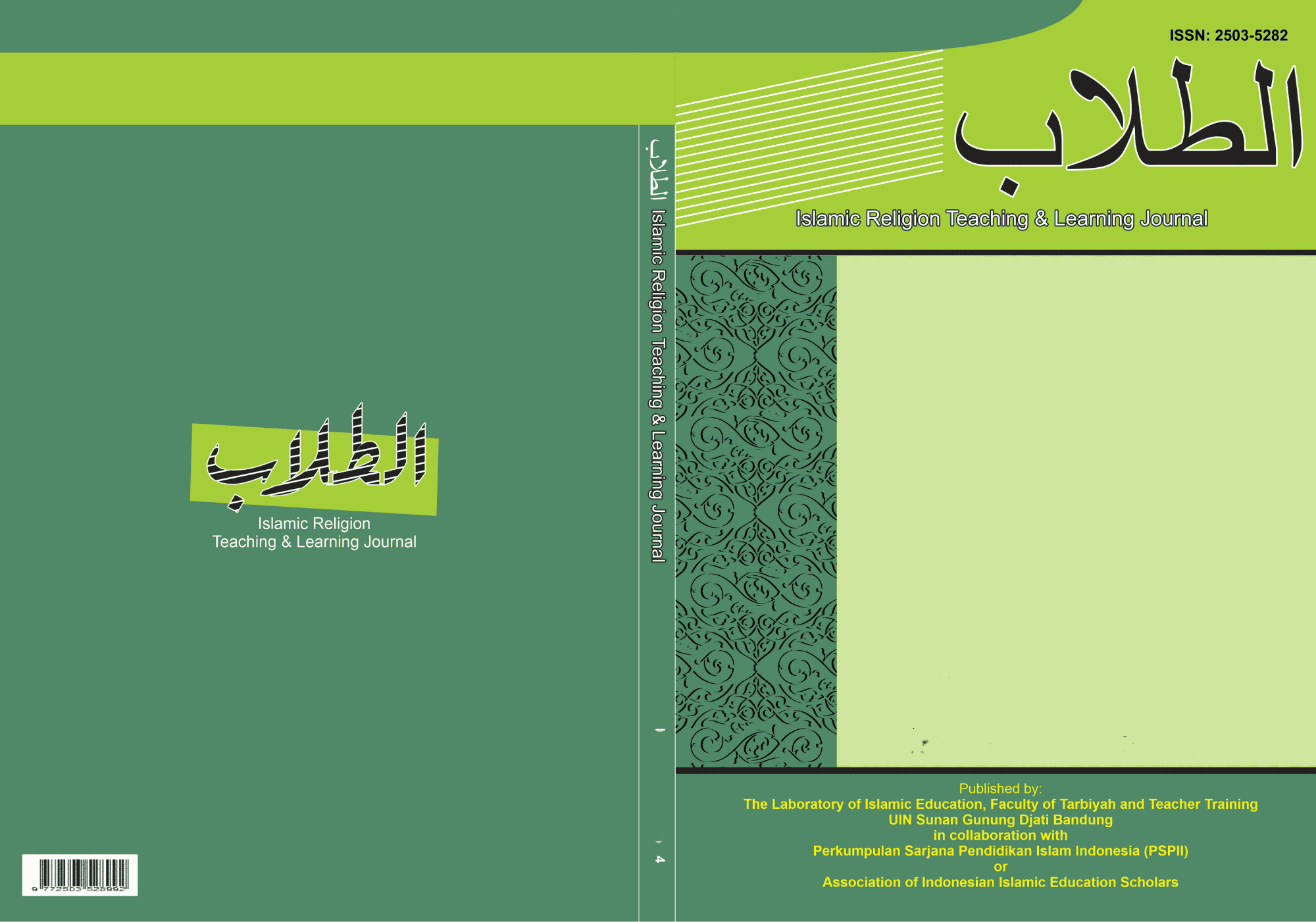Maximizing the Use of Educational Media in Forming Anti-Bullying Values in School in Post-Truth Era
DOI:
https://doi.org/10.15575/ath.v9i1.33798Keywords:
Anti-Bullying Values, Educational Media, Instilling, Post Truth EraAbstract
Post truth is a phenomenon in which a person's mindset is formed by various information that is often displayed in various media. This phenomenon marks the importance of media in forming beliefs, so that ultimately moves someone to act. This theoretical research aims to determine how media can be used to instill anti-bullying values in schools. This research is qualitative research with a literature review approach, where the data sources come from books and journals that are appropriate to the topic of discussion. The data and information obtained were then collected, coded and appropriate themes were searched for and then analyzed. The research results show that; Forms of bullying at school have occurred in several forms, namely: verbal, physical, social, cyber, sexual. So this needs to be addressed immediately by instilling anti-bullying values, which can be done using educational media. Maximizing the use of educational media is an effective way in the post truth era to instill anti-bullying values in schools. This is because, in this era, the form of information in the media has become a determinant and is able to shape a person's mindset to act.
Post truth merupakan fenomena dimana pola pikir seseorang terbentuk dari berbagai informasi yang sering ditampilkan di berbagai media. Fenomena ini menandai pentingnya media dalam membentuk keyakinan, yang mana hal tersebut mampu menggerakkan seseorang untuk bertindak. Penelitian teoritik ini bertujuan untuk mengetahui penggunaan media bisa digunakan dalam menanamkan nilai-nilai anti bullying di sekolah. Penelitian ini merupakan penelitian kualitatif dengan pendekatan literatur review, dimana sumber datanya berasal dari buku dan jurnal yang sesuai dengan topik pembahasan. Data dan informasi yang diperoleh kemudian dikumpulkan, diberi kode dan dicari tema yang sesuai lalu dianalisis. Hasil penelitian menunjukkan bahwa; Bentuk-bentuk bullying di sekolah terjadi dalam beberapa bentuk yaitu: verbal, fisik, sosial, cyber, seksual. Sehingga hal ini perlu segera diatasi dengan penanaman nilai-nilai anti bullying yang dapat dilakukan melalui media pendidikan. Pemaksimalan penggunaan media pendidikan menjadi salah satu cara yang efektif di era post truth dalam menanamkan nilai-nilai anti bullying di sekolah. Hal ini dikarenakan, bahwa pada era ini segara bentuk informasi di media sudah menjadi penentu dan mampu membentuk pola pikir seseorang untuk bertindak.References
Alimi, M. Y. (2018). Mediatisasi agama, Post Truth Dan ketahanan Nasional: Sosiologi Agama Era Digital. LKis.
Aliyyah, R. R., Amini, A., Subasman, I., Sri, E., Herawati, B., & Febiantina, S. (2021). Upaya Meningkatkan Hasil Belajar Ipa Melalui Penggunaan Media Video Pembelajaran. Jurnal Sosial Humaniora, 12(1). https://doi.org/10.30997/jsh.v12i1.4034
Andra, S. (2017). Efektifitas Penggunaan Media Luar Ruang Dalam Mempromosikan Pariwisata Kota Samarinda. EJournal Lmu Komunikasi, 5(2). Retrive From https://ejournal.ilkom.fisip-unmul.ac.id/site/wp-content/uploads/2017/06/EJOURNAL%20SYAIF%20(FORMAT%20ONLINE)%20(06-13-17-08-21-33).pdf
Asnawir, B. U. (2002). Media Pembelajaran. Ciputat Press.
Asri, K. H. (2023). Bullying is not cool: mari berteman dengan asik tanpa mengusik. Indonesia Emas Group.
Barus, J., Ninda Safitri, & Husaini. (2023). Study of Verbal Bullying in Early Adolescents. Journal for Lesson and Learning Studies, 6(1). https://doi.org/10.23887/jlls.v6i1.61003
Bufacchi, V. (2021). Truth, lies and tweets: A Consensus Theory of Post-Truth. Philosophy and Social Criticism, 47(3). https://doi.org/10.1177/0191453719896382
Desmiarti. (2023). Dampak Psikologis bagi Korban Cyberbullying “Luka yang Tak Terlihat.†Kementerian Kesehatan. https://yankes.kemkes.go.id/view_artikel/2788/dampak-psikologis-bagi-korban-cyberbullying-luka-yang-tak-terlihat
Else, H. (2018). Does science have a bullying problem? Nature. https://doi.org/10.1038/d41586-018-07532-5
Firdaus, J., & Aisyah, N. (2020). Revitalisasi Nilai-nilai Pendidikan Agama Islam Dalam Menanggulangi Problematika Bullying Di Pesantren. Jurnal Sains Sosio Humaniora, 4(2). https://doi.org/10.22437/jssh.v4i2.11734
Gohal, G., Alqassim, A., Eltyeb, E., Rayyani, A., Hakami, B., Al Faqih, A., Hakami, A., Qadri, A., & Mahfouz, M. (2023). Prevalence and related risks of cyberbullying and its effects on adolescent. BMC Psychiatry, 23(1). https://doi.org/10.1186/s12888-023-04542-0
Guerra, R. L. L. (2020). A perspective on retina education through social media. In International Journal of Retina and Vitreous (Vol. 6, Issue 1). https://doi.org/10.1186/s40942-020-00244-x
Hertinjung, W. S. (2013). BENTUK-BENTUK PERILAKU BULLYING DI SEKOLAH DASAR. Seminar Nasional Psikologi UMS 2013 - Parenting, 53(9). Retrive From https://publikasiilmiah.ums.ac.id/xmlui/bitstream/handle/11617/3952/D7.pdf?sequence=1
Hidayanti, I., Yulianti, L., Bancin, L. K., & Sasmi, W. T. (2023). Penanganan Bullying Dengan Menanamkan Pendidikan Karakter Pada Siswa SDN Duren I. Jurnal Pendidikan Dan Konseling, 5(1). https://doi.org/10.31004/jpdk.v5i1.10880
Kapolkas, I. (2017). Affective Capacity in Post-Truth Politics. Rereading Spinoza’s Ethics. https://www.psa.ac.uk/sites/default/files/conference/papers/2018/PSA Full Paper.pdf
Kemendikbudristek. (2023). Peraturan Menteri Nomor 46 tentang Pencegahan dan Penanganan Kekerasan di Lingkungan Satuan Pendidikan. https://jdih.kemdikbud.go.id/detail_peraturan?main=3310
Khaliza, C. N., Besral, B., Ariawan, I., & EL-Matury, H. J. (2021). Efek Bullying, Kekerasan Fisik, dan Kekerasan Seksual terhadap Gejala Depresi pada Pelajar SMP dan SMA di Indonesia: Analisis Data Global School-Based Student Health Survey Indonesia 2015. Jurnal Penelitian Dan Pengembangan Kesehatan Masyarakat Indonesia, 2(2). https://doi.org/10.15294/jppkmi.v2i2.53149
Khasanah, I. (2015). Program “SAHABAT†Sebagai Salah Satu Program Alternatif Penanganan Bullying Pada Anak Usia Dini. Jurnal Pendidikan Anak, 2(2). https://doi.org/10.21831/jpa.v2i2.3049
Linasari, T. (2016). Keefektifan videotherapy dalam menumbuhkan kesadaran anti-bullying pada siswa kelas V. Jurnal Pendidikan Guru Sekolah Dasar, 36(5). Retrive From https://journal.student.uny.ac.id/index.php/pgsd/article/viewFile/5365/5072
Matthew, B. M., & Huberman, A. M. (1984). Qualitative Data Analysis. Sage Publication.
Maulani, S., Nuraisyah, N., Zarina, D., Velinda, I., & Aeni, A. N. (2022). Analisis Penggunaan Video sebagai Media Pembelajaran Terpadu terhadap Motivasi Belajar Siswa. Jurnal Pendidikan Dan Teknologi Indonesia, 2(1). https://doi.org/10.52436/1.jpti.134
Mendeley. (2023). Bulliying. https://www.mendeley.com/search/?page=1&query=inovasi pendidikan&sortBy=relevance
Mustika, R. (2015). Media Pembelajaran Sistem Audio Untuk Pemberdayaan. Jurnal Masyarakat Telematika Dan Informasi, 6(1). Retrive From https://www.neliti.com/publications/233746/media-pembelajaran-sistem-audio-untuk-pemberdayaan-pendidikan-di-komunitas-masya
Nabayra, J. N. (2023). Teacher-Made Videos as Learning Tool in Elementary Statistics during the Pandemic: A Developmental Research. International Journal of Information and Education Technology, 13(1). https://doi.org/10.18178/ijiet.2023.13.1.1774
Ningsih, W. T., & Sumiatin, T. (2023). Efektifitas Pendidikan Kesehatan Ceramah dan Role Play Penanganan Bullying pada Remaja dalam Meningkatkan Pengetahuan. Nursing Sciences Journal, 7(1). https://doi.org/10.30737/nsj.v7i1.4309
Page, E., Shute, R., & McLachlan, A. (2015). A Self-Categorization Theory Perspective on Adolescent Boys’ Sexual Bullying of Girls. Journal of Interpersonal Violence, 30(3). https://doi.org/10.1177/0886260514535096
Priyanto, & Nur Huda. (2023). UPAYA PENANGANAN BULLYING DI SMP AR RAHMAH ISLAMIC BOARDING SCHOOL MALANG. Ta’dibi : Jurnal Manajemen Pendidikan Islam, 12(1). https://doi.org/10.61088/tadibi.v12i1.630
Ramli, A., Dhahri, I., Solehuddin, M., Rahmah, S., Haris, M., & Lubis, F. M. (2023). The Urgency of Islamic Character Education to Anticipate Bullying Behavior in Boarding Schools. At-Ta’dib, 18(1). https://doi.org/10.21111/attadib.v18i1.9823
Rosa, N. (2023). Data Kasus Bullying di Sekolah, FSGI: 50% di Jenjang SMP. DetikEdu. https://www.detik.com/edu/detikpedia/d-6962155/data-kasus-bullying-di-sekolah-fsgi-50-di-jenjang-smp
Russell, S. T., Day, J. K., Ioverno, S., & Toomey, R. B. (2016). Are school policies focused on sexual orientation and gender identity associated with less bullying? Teachers’ perspectives. Journal of School Psychology, 54. https://doi.org/10.1016/j.jsp.2015.10.005
Saingo, Y. A. (2022). Pemanfaatan Media Sosial Sebagai Sarana Pembentukan Karakter Kristiani Tingkat Sekolah Menengah Pertama. Jurnal Shanan, 6(1). https://doi.org/10.33541/shanan.v6i1.3652
Santoso, A. (2018). Pendidikan Anti Bullying. Majalah Ilmiah “Pelita Ilmu,†1(2). Retrive From http://jurnal.stiapembangunanjember.ac.id/index.php/pelitailmu/article/download/103/109
Sofhie Awalia Ajoen Vania. (2023). Analisis Faktor Dan Cara Penanganan Bullying. Jurnal Riset Sosial Humaniora Dan Pendidikan, 2(3). https://doi.org/10.56444/soshumdik.v2i3.1027
Suciartini, N. N. A., & Sumartini, N. (2018). Verbal Bullying Dalam Media Sosial Ditinjau Dari Perspektif Penyimpangan Prinsip Kesantunan Berbahasa. … : Jurnal Ilmu Sosial …. Retrive From https://jayapanguspress.penerbit.org/index.php/ganaya/article/download/93/91
Sun, J., & Cao, L. (2022). Explaining Physical Bullying in Chinese Middle Schools. Journal of School Violence, 21(1). https://doi.org/10.1080/15388220.2021.1985324
Vekovtseva, V., & Plotnikova, P. (2019). The Role of Creative Concept and Speech Organization in the Creation of Modern Advertising Posters. JOURNAL OF EDUCATION AND HUMAN DEVELOPMENT, 8(2). https://doi.org/10.15640/jehd.v8n2a14
Visty, S. A. (2021). DAMPAK BULLYING TERHADAP PERILAKU REMAJA MASA KINI. Jurnal Intervensi Sosial Dan Pembangunan (JISP), 2(1). https://doi.org/10.30596/jisp.v2i1.3976
Wahyuni, H. (2023). Efektivitas Pendidikan Karakter “CARE†Sebagai Sarana Literasi Pencegahan dan Penanganan Bullying Pada Anak Di Madura. Journal of Social, Culture, and Language, 2(1). https://doi.org/10.21107/jscl.v2i1.22876
Wolf, J. M. (2017). The Multipurpose Tool of Social Media: Applications for Scientists, Science Communicators, and Educators. Clinical Microbiology Newsletter, 39(10). https://doi.org/10.1016/j.clinmicnews.2017.04.003
Wulandari, A. P., Salsabila, A. A., Cahyani, K., Nurazizah, T. S., & Ulfiah, Z. (2023). Pentingnya Media Pembelajaran dalam Proses Belajar Mengajar. Journal on Education, 5(2). https://doi.org/10.31004/joe.v5i2.1074
Yuliani, N. (2019). Fenomena Kasus Bullying Di Sekolah. Research Gate. Retrive From https://osf.io/preprints/inarxiv/maqtx/download
Yunitasari, P., Isnugroho, H., & Sulistyowati, E. T. (2021). Dampak Bulliying di Sekolah Terhadap Kesehatan Mental Remaja. Jurnal Keperawatan, 13(1). https://doi.org/10.32583/keperawatan.v13i2.949
Downloads
Published
How to Cite
Issue
Section
License
Authors who publish with this journal agree to the following terms:
- Authors retain copyright and grant the journal right of first publication with the work simultaneously licensed under a Creative Commons Attribution-ShareAlike License that allows others to share the work with an acknowledgement of the work's authorship and initial publication in this journal.
- Authors are able to enter into separate, additional contractual arrangements for the non-exclusive distribution of the journal's published version of the work (e.g., post it to an institutional repository or publish it in a book), with an acknowledgement of its initial publication in this journal.
- Authors are permitted and encouraged to post their work online (e.g., in institutional repositories or on their website) prior to and during the submission process, as it can lead to productive exchanges, as well as earlier and greater citation of published work (See The Effect of Open Access).




